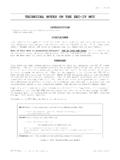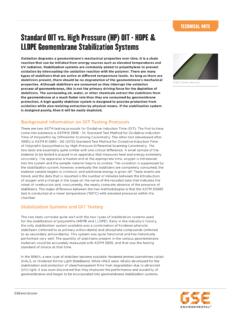Transcription of Engineer-to-Engineer Note EE-269
1 Engineer-to-Engineer Note EE-269 . technical notes on using analog devices DSPs, processors and development tools a Contact our technical support at and Or visit our on-line resources and A Beginner's Guide to Ethernet Contributed by Ralf Neuhaus Rev 1 June 6, 2005. Introduction EE-Note Ethernet Network Interface for ADSP- BF535 Blackfin Processors (EE-214). [17]. This EE-Note provides an overview of the Ethernet specification and some popular protocols that can be used on top of an History Ethernet driver. The goal is to provide the reader The Ethernet Sourcebook, ed. Robyn E. with the fundamentals of the protocols and the Shotwell (New York: North-Holland, 1985), title hardware. The figures and explanations will page. provide excellent guidance for anyone starting When we talk about Ethernet , we refer to the off on Ethernet.
2 This EE-Note does not show any implementation methods of layer 1 and layer 2 of software implementations such as a TCP/IP. the Open Systems Interconnection model stack, but will simplify their use. (OSI model). Additionally, this EE-Note serves as the These layers form the physical layer for various theoretical complement to the Ethernet MAC. Ethernet hardware implementations, while the chapter of the ADSP-BF537 Blackfin . other OSI layers are implemented in software. Processor Hardware Reference [16] and to the ``The diagram .. was drawn by Dr. Robert M. Metcalfe in 1976 to present Ethernet .. to the National Computer Conference in June of that year. On the drawing are the original terms for describing Ethernet. Since then other terms have come into usage among Ethernet enthusiasts.
3 ' . Figure 1. Ethernet History Copyright 2005, analog devices , Inc. All rights reserved. analog devices assumes no responsibility for customer product design or the use or application of customers' products or for any infringements of patents or rights of others which may result from analog devices assistance. All trademarks and logos are property of their respective holders. Information furnished by analog devices applications and development tools engineers is believed to be accurate and reliable, however no responsibility is assumed by analog devices regarding technical accuracy and topicality of the content provided in analog devices Engineer-to-Engineer notes . a OSI Model It consists of seven layers and each layer describes the status of the communications, , The OSI model provides a standard description Ethernet.
4 Or "reference model" for how messages should be transmitted between any two points in a Figure 2 compares the OSI model with the telecommunication network. TCP/IP model and its protocols. Layer OSI model TCP/IP model TCP/IP protocols 7 Application Application NFS. Layer HTTP FTP SMTP Name Server 6 Presentation XDR. Layer 5 Session RPC. Layer 4 Transport Transport Transmission Control User Data Protocol Layer Protocol TCP UDP. 3 Network Internet Layer Internet Protocol IP. 2 Data Link Network Ethernet Token Ring DQDB. Layer IEEE 1 Physical twisted optical coaxial cable Layer Pair fiber Figure 2. Comparison between OSI and TCP/IP Models TCP/IP Model UDP is a very simple protocol and is perfect for The TCP/IP model consists of four layers.
5 Streaming sequences ( , audio or video). TCP is a highly reliable host-to-host protocol for Network Layer a controlled connection. TCP is appropriate for The Network layer combines the Data Link layer applications that require guaranteed delivery. and Physical layer, including the twisted pair cable, the Physical layer device (PHY), and the Application Layer Ethernet Media Access Controller (MAC). The Application layer includes all available software implementations ( , FTP, HTTP, Internet Layer SMTP, DNS, ) that make up the lower layers. The Internet layer consists primarily of a These applications can work only in combination software implementation. The IP header is with the API of TCP or UDP, which form the evaluated or generated by software.
6 Software implementation of the Transport layer. Transport Layer The Transport layer defines what should be done TCP/IP Protocols with the data. This layer is based on the The third column of Figure 2 shows possible following two popular protocols: ways (combinations of sub protocols and A Beginner's Guide to Ethernet ( EE-269 ) Page 2 of 26. a physical medium) to build a stack. For instance, 10 Mbit/s FTP, HTTP, or SMTP applications can use TCP, | ---------10 Base2. IP, Ethernet IEEE , and the twisted-pair |----------10 Base5. cable as one way. |----------10 Base-T. |----------FOIRL 10 Base-F. There are many more protocols |--------------10 Base-FB. established as shown in Figure 2. |--------------10 Base-FP. |--------------10 Base-FL.
7 RFCs 100 Mbit/s RFCs (request for comments) are very popular in |----------100 Base-T4. the Ethernet community and form a type of |----------100 Base-X. regulation system. RFCs describe many of the |--------------100 Base-TX. Internet protocols as well as standards, |--------------100 Base-FX. procedures, rules, algorithms, and strategies for 1000 Mbit/s the communication and network area. An RFC. |----------1000 Base-T. starts as a recommendation; after successful discussion, it is then approved by the Internet |----------1000 Base-X. community. After publication, this |--------------1000 Base-SX. recommendation will be mostly accepted by the |--------------1000 Base-LX. market. For instance, decisions of the IAB |--------------1000 Base-CX.
8 (Internet Architecture Board) are always legend : published as RCFs. 2 = thin coaxial S = short wavelength The most important protocols are: 5 = thick coaxial L = long wavelength RFC 768 User Data Protocol T = twisted pair C = short copper cable RFC 793 Transmission Control Protocol F = fiber optics RFC 791 Internet Protocol RFC 792 Internet Control Massage Protocol FOIRL = Fiber Optic Inter-Repeater Link RFC 826 Address Resolution Protocol Figure 3. Ethernet Family Tree RFCs are one of the main ingredients which contribute to the success story of the Ethernet. Hardware Ethernet Family Tree This section goes deeper in the Physical and Data Link layer of the OSI model. It also describes the The Ethernet family tree (Figure 3) gives an RJ45 jack, Magnetic, Power over Ethernet (PoE), overview about the class with the reference to the and Media Independent Interface (MII) interface.
9 Transport medium. This EE-Note described All frequencies are shown in detail to provide the 10 Base-T and 100 Base-TX Ethernet only. reader with a feeling of the signal chain in the Physical layer and the Data Link layer. A Beginner's Guide to Ethernet ( EE-269 ) Page 3 of 26. a Overview depends on the medium only, such as 10 BaseT. Figure 4 shows layer 1 and layer 2 in detail and and 100 BaseTX (speed) or 100 BaseTX and describe all sub-layers of the PHY. For further 100 BaseFX (twisted pair - optical), and so on. information, refer to specification This EE-Note describes focuses on the 10 BaseT. 2002. and the 100 BaseTX standards. These standards Generally, PHYs work in layer 1, and use the following coding mechanisms. Ethernet MACs are placed in layer 2.
10 10 Mbit/s = Manchester coding 100 Mbit/s = 4B/5B coding Manchester (PCS layer): Ethernet uses Manchester Phase Encoding (MPE) as the support medium for 10 BaseT. systems. A data bit '1' from the level-encoded signal is represented by a full cycle of the inverted signal from the master clock, which matches with the '0'. to '1' rise of the phase-encoded signal ( , -V in the first half and +V in the second half of the signal. The data bit '0' from the level-encoded signal is represented by a full normal cycle of the master Figure 4. PHY and MAC Layer 100-Mbit Network clock, which gives the '1' to '0' fall of the phase- encoded signal ( , +V in the first half and -V in * MII is optional for 10 Mb/s DTEs and for 100 Mb/s systems and is not specified for 1 Mb/s systems.))

















